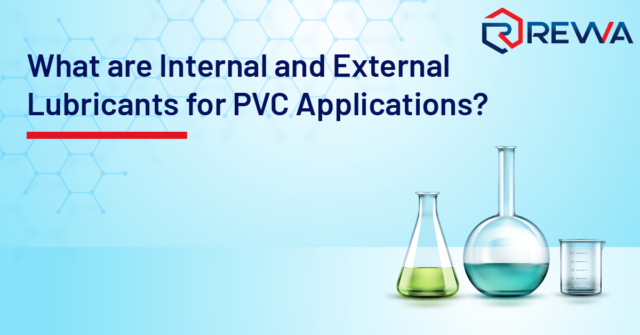In PVC processing, the role of lubricants as an additive is indispensable. Lubricants internally improve the flow characteristics of the PVC melt during processing and externally reduce friction between the PVC melt and the metal surfaces of the processing equipment. This summarizes the two kinds of lubricants that we encounter for PVC applications: Internal and External Lubricants.
Let us dig deeper and analyze the uses of internal and external lubricants for PVC applications from a technical standpoint:
Internal Lubricants for PVC applications
● Internal lubricants used for PVC processing reduce mutual attraction between the PVC’s molecular chains and promote the flow between the molecule via chain slippage. They are also known as processing aids or melt flow enhancers.
● In PVC processing, when the melt is injected in a mold under high pressure, melt fracture can be easily caused, leaving burn marks on the product surface. Using the correct PVC lubrication in the proper quantity reduces the likelihood of burn marks on the final product.
● During the injection molding of polymers, the most common defect is the formation of small depressions. While these depressions do not affect any physical features of the PVC, they can compromise the aesthetic appeal of the final product. Proper use of lubricants can reduce the chance of small depression formations and enhance the product’s surface finish.
● Ester Lubricants, Oleochemical Derivatives and N-Butyl Stearate are commonly used Internal Lubricants for PVC applications.
External Lubricants for PVC applications
● External lubricants reduce the friction between the PVC melt and the metal surfaces of the processing equipment. They tend to exude to the surface of the PVC, forming a lubricating layer that helps in the release of the PVC product from the mold or processing machine.
● Unlike Internal Lubricants, which deals with friction within the PVC melt, these lubricants deal with surface lubrication.
● External Lubricants ensure a smooth processing experience, facilitate easy demolding, and prevent PVC from sticking to the machinery.
● The additional feature of External Lubricants is that they make the end product glossier and helps increase its lifespan.
● Polyethylene Wax and Amide based Wax are commonly used External Lubricants for PVC applications.
There are certain lubricants that can effectively be used as both External and Internal Lubricants. Examples of such lubricants are Lubricant Blends are manufactured by Rewa Stabilizers & Lubricants Pvt. Ltd.
While PVC Lubricants are essential to be added in polymer formulation, there are certain parameters to be followed while adding lubricants. Under or over-lubrication can negatively affect the quality of PVC. Let us understand what happens if PVC Lubricants are not used correctly.
What happens if you use the Lubricants incorrectly?
● Excessive Internal Lubrication can lead to unusually faster extrusion rate, leading to poor plasticization, a decrease in quality, and poor surface properties of PVC.
● There can also be many processing issues leading to defects in the product and a reduction in the impact strength of the product.
● Insufficient lubrication can increase the shear load, leading to corrosion damage such as crackling and pitting.
● Moreover, under lubrication can lead to loss of mechanical properties and even degradation of PVC.
Conclusion
While lubricants are essential for PVC formulations, all Lubricants must be adequately evaluated in the laboratory. Using the right kind of PVC lubricating additive is essential. Understanding the lubricants requires an in-depth knowledge of polymer formulation and processing. With Rewa’s four decades of experience in the field of additives, we can provide technical support and conduct trials for our clients to determine the right kind and amount of lubricant additive to be added according to your application.
FAQ
What are the two types of lubricants?Internal and External Lubricants are two types of lubricants used in PVC applications. What is an example of an internal lubricant?Oleochemical derivatives, Ester, and N- Butyl stearate are examples of internal What is an external lubricant?Unlike internal lubricants that enhance the polymer melt’s flow properties, external What is the difference between internal and external lubricants?Internal Lubricants improve the flow characteristics of the PVC melt during processing |


